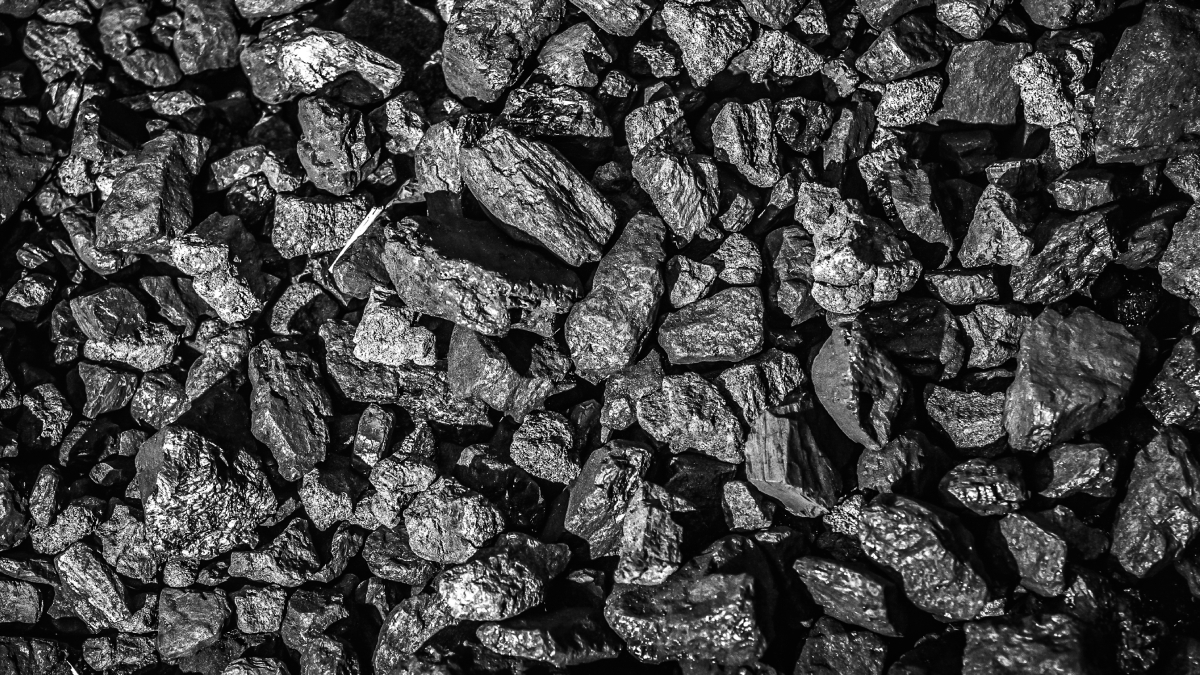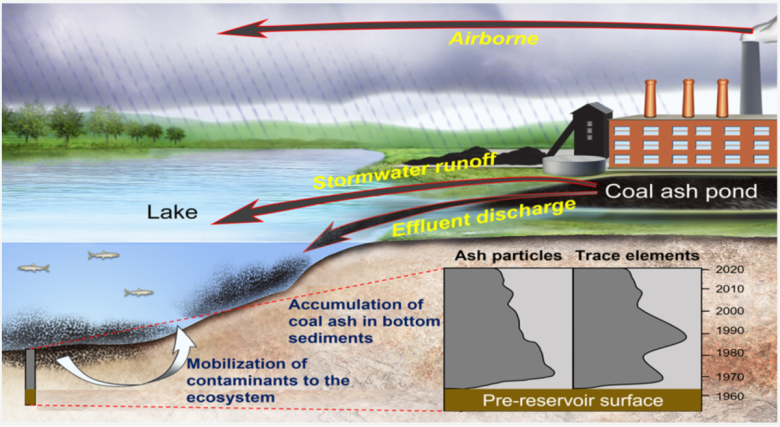Coal ash–polluted lakes are in
residential and recreational areas, invoking concern for the health of local
residents and ecosystems.
By Kimberly
M. S. Cartier14 October 2022

 Credit:
alexanderuhrin/Adobe Stock
Credit:
alexanderuhrin/Adobe Stock
Sediment
cores taken from five lakes in North Carolina reveal the state’s history of
coal ash pollution from power plants. Analysis of these cores, published in Environmental
Science and Technology, explains that although coal ash deposition has
declined in recent years, its legacy lives on in the contaminants the ash left
behind to seep into the environment. These toxins could be affecting the health
of local residents and ecosystems.
“It looks very pristine and beautiful, but if you dig in, you
find piles of toxic coal ash.”
“These
are recreational lakes,” Zhen Wang, an environmental geochemistry
doctoral student at Duke University in Durham, N.C., and the lead author of the
study, said in a statement. “Some of
them…were originally built for the coal plant, but over the years, it has
become very desirable real estate where people build their dream homes. It
looks very pristine and beautiful, but if you dig in, you find piles of toxic
coal ash.”
Decades of Pollution
Coal ash is the by-product of burning
coal and is one of the most prevalent forms of industrial waste in the United
States—around 130 million metric tons are
produced every year. Ash contains toxic metals, including lead, mercury,
arsenic, and selenium, which can cause respiratory diseases and cancers
after short- or long-term exposure.
Coauthor Avner Vengosh of Duke University and his
colleagues have been investigating the water quality of lakes and groundwater
across North Carolina for more than a decade. Some of their past work has
focused on pollution in the five artificial lakes sampled in the new study—Hyco
Lake, Mayo Lake, Belews Lake, Mountain Island Lake, and Lake Sutton—each of
which is located near a coal plant.
The
team collected cores up to 70 centimeters deep from the lakes between July 2020
and August 2021. They also collected a core from Lake Waccamaw, a natural lake
close to Lake Sutton, for comparison. “The oldest sediments we collected were
aged to mid-1950s,” Vengosh said, “representing 60–70 years of sedimentation.”
Some of the cores look back to before the nearby coal plants were installed and
provide a good baseline to understand a plant’s environmental impact. For each
core, the researchers analyzed the morphology, magnetic and geochemical
properties, and strontium isotopes of the lake sediments and the embedded coal
ash to track the history of ash deposition into the lakes.
The
cores revealed three distinct phases of coal ash release into the lakes. The
first phase, from the 1960s to 1970s, saw significant deposition of both coarse
and fine-grained ash particles as ash was dumped right into the lakes. During
the second phase, from the 1970s to 1990s, the enactment of the Clean Air Act
meant that coal ash was stored in ponds next to the plant. The level of
pollution into the nearby lakes decreased during this time, and larger
particles were captured by air filters instead of entering the environment. The
third phase, from the 1990s to the present, also saw a decrease in the quantity
of coal ash deposited into the lakes as storage changed from wet coal ash ponds
to dry landfills and a few plants shifted from coal to natural gas for energy
production.
Using
streamflow data from the U.S. Geological Survey, the team found that the lakes
accumulated more coal ash during times of high streamflow and precipitation.
This result suggests that stormwater runoff, flooding, and effluent discharge
from coal ash ponds and dry landfills are some of the main mechanisms by which
the ash enters nearby lakes. Ash can also enter the air, land in the
surrounding landscape, and be washed into the lakes by rain. The researchers
noted that climate change continues to heighten the severity of the storms
striking North Carolina, including hurricanes like Florence in 2018, which
bodes ill for the coal ash still stored at these plants.

 Research
speculates that coal ash enters North Carolina lakes via three pathways:
airborne ash that settles into the lakes and surrounding landscape, stormwater
runoff from coal ash ponds, and effluent discharge from coal ash ponds. Once in
the lake bottom sediments, the coal ash can release contaminants into the
water, increasing their bioavailability. Credit: Wang et al., 2022, https://doi.org/10.1021/acs.est.2c04717
Research
speculates that coal ash enters North Carolina lakes via three pathways:
airborne ash that settles into the lakes and surrounding landscape, stormwater
runoff from coal ash ponds, and effluent discharge from coal ash ponds. Once in
the lake bottom sediments, the coal ash can release contaminants into the
water, increasing their bioavailability. Credit: Wang et al., 2022, https://doi.org/10.1021/acs.est.2c04717
A Toxic Legacy
“The problem of coal ash legacy did not go away by switching to
natural gas.”
The
plants near Hyco, Mayo, and Belews Lakes continue to burn coal for power; the
Sutton Plant has switched to natural gas, and the Riverbend Plant near Mountain
Island Lake has been retired. But the toxic legacy of all of these energy
plants continues. “Coal ash that was stored in the nearby coal ash ponds seems
to continue [to be] displaced and transported into the lakes, specifically
during times of major flooding like hurricane episodes,” Vengosh said. “The
problem of coal ash legacy did not go away by switching to natural gas.”
Once
in the lake bed, the coal ash breaks down and releases contaminants into the water.
Those contaminants become bioavailable, which is a concern for the local
ecosystems and the residents who live nearby. All five lakes are destinations
for recreational boating, fishing, and camping, and Hyco Lake is also a
residential area.
What’s
more, Mountain Island Lake is a local drinking water intake, noted Amanda
Strawderman, polluter accountability program director for the nonprofit Clean
Water for North Carolina. This study raises pressing questions, she
said. “To what degree could suspended particles of coal ash be taken into the
municipal drinking water treatment system? Is this water being tested and
remediated for toxic coal ash constituents? If remediation is taking place, to
what extent are those 800,000 residents of the Charlotte/Mecklenburg area
bearing the cost burden of that remediation through water rates?”
“The assembly of contaminants in coal ash are highly toxic.”
This
study examined the environmental risks of
bioaccumulation of coal ash pollutants, Vengosh said, but “it is well known
that the assembly of contaminants in coal ash are highly toxic [to people].
There are reports that many
workers who participated in the cleanup of the coal ash spill in the Tennessee Valley Authority [in
2008] became severely sick, with a
high percentage of cancer. Many of them
have already passed.”
“This
alarming study reinforces the need to regulate generation and management of
coal ash waste to understand where coal ash exists,” Strawderman added, “and
strengthen protections for communities in North Carolina and beyond.”
—Kimberly
M. S. Cartier (@AstroKimCartier), Staff Writer
Citation: Cartier, K. M. S. (2022), Lake sediments record
North Carolina’s coal legacy, Eos, 103, https://doi.org/10.1029/2022EO220491.
Published on 14 October 2022.
(Source: https://eos.org/articles/lake-sediments-record-north-carolinas-coal-legacy)

